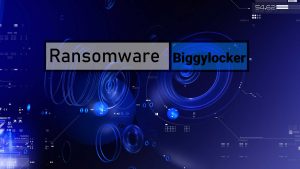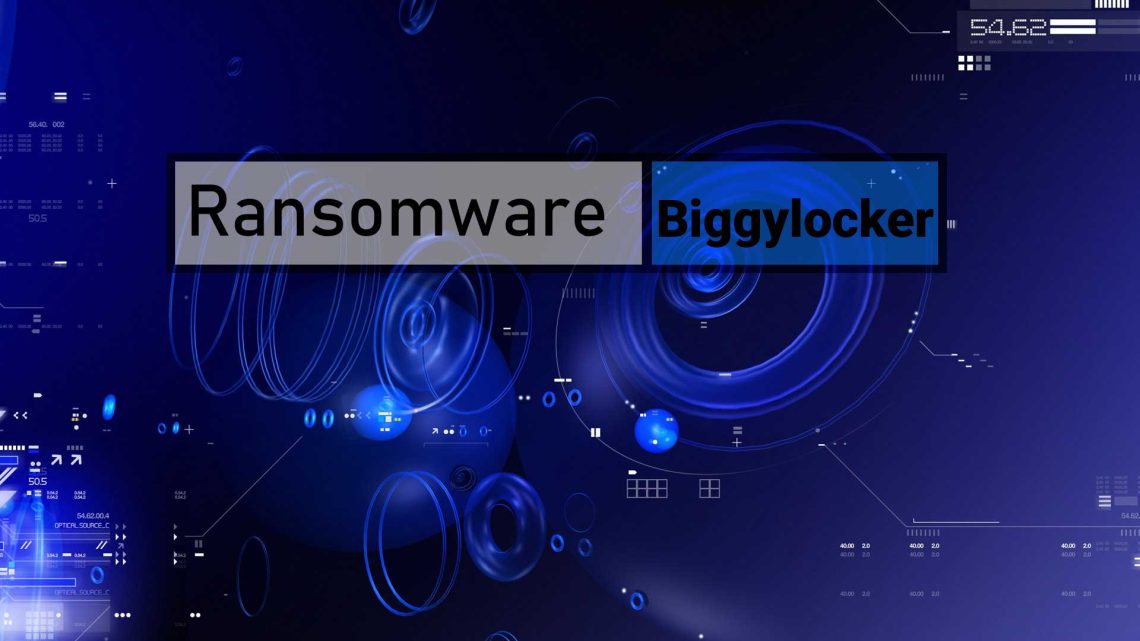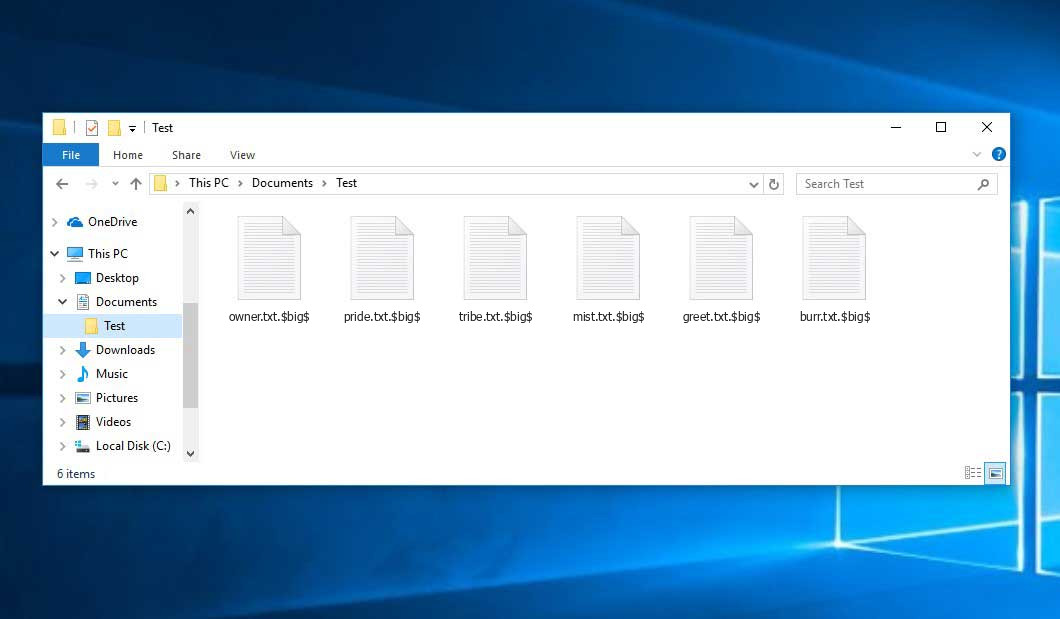The Biggylocker virus falls within the ransomware type of malicious agent. Harmful software of this type encrypts all the data on your PC (images, documents, excel tables, music, videos, etc) and adds its extra extension to every file, leaving the read_me.txt files in each directory with the encrypted files.
What is Biggylocker virus?
☝️ A scientifically accurate denomination for the Biggylocker is “a ransomware-type infection”.
Biggylocker appends its specific .$big$ extension to the name of each encoded file. For example, a file entitled “photo.jpg” will be turned into “photo.jpg.$big$”. In the same manner, the Excel file with the name “table.xlsx” will end up as “table.xlsx.$big$”, and so on.
In every folder that contains the encoded files, a read_me.txt file will be created. It is a ransom money note. Therein you can find information on the ways of contacting the racketeers and some other information. The ransom note usually contains a description of how to buy the decryption tool from the Biggylocker developers. You can obtain this decrypting software after contacting [email protected] via email. That is how they do it.
Biggylocker overview:
| Name | Biggylocker Virus |
| Extension | .$big$ |
| Ransomware note | read_me.txt |
| Ransom | $120 |
| Contact | [email protected] |
| Detection | Win32/Packed.BlackMoon.A suspicious, BScope.TrojanDownloader.Deyma, Mal/Kryptik-BX |
| Symptoms | Your files (photos, videos, documents) have a .$big$ extension and you can’t open them. |
| Fix Tool | See If Your System Has Been Affected by Biggylocker virus |
The read_me.txt file coming in package with the Biggylocker ransomware states the following:
$$$BiggyLocker$$$ ransomware Your files are encrypted with a AES and RSA algorithm , it is unbreakable . you can\'t recover your files without our decryption service , the price is 120 USD in bitcoin after the payment you must email us at : [email protected] to prove us that you pay. - do not use any decryption tools because those tools will just destroy your files , making recover impossible . - do not rename your files . our bitcoin address : 36zvYAn9vtbWQFcKcidPKhcuAz6woMszE9 or bc1qw0ll8p9m8uezhqhyd7z459ajrk722yn8c5j4fg we guarantee you will receive the decryption software after the payment . greeting !
In the picture below, you can see what a directory with files encrypted by the Biggylocker looks like. Each filename has the “.$big$” extension added to it.
How did my computer get infected with Biggylocker ransomware?
There are plenty of possible ways of ransomware infiltration.
Nowadays, there are three most exploited methods for malefactors to have the Biggylocker virus planted in your digital environment. These are email spam, Trojan injection and peer-to-peer file transfer.
If you access your mailbox and see emails that look like familiar notifications from utility services companies, postal agencies like FedEx, Internet providers, and whatnot, but whose “from” field is strange to you, be wary of opening those emails. They are very likely to have a malware item enclosed in them. Therefore, it is even riskier to open any attachments that come with letters like these.
Another thing the hackers might try is a Trojan horse scheme1. A Trojan is an object that gets into your computer pretending to be something else. For instance, you download an installer of some program you need or an update for some software. But what is unboxed reveals itself a harmful agent that encrypts your data. As the installation wizard can have any name and any icon, you have to make sure that you can trust the source of the things you’re downloading. The optimal thing is to use the software developers’ official websites.
As for the peer-to-peer file transfer protocols like BitTorrent or eMule, the danger is that they are even more trust-based than the rest of the Internet. You can never guess what you download until you get it. So you’d better be using trustworthy websites. Also, it is a good idea to scan the directory containing the downloaded files with the antivirus as soon as the downloading is done.
How do I get rid of the Biggylocker virus?
It is important to note that besides encrypting your files, the Biggylocker virus will probably install the Azorult Spyware on your computer to get access to credentials to different accounts (including cryptocurrency wallets). That spyware2 can derive your credentials from your browser’s auto-filling cardfile.
Often criminals would unblock some of your files so you know that they really have the decryption program. Since Biggylocker virus is a relatively recent ransomware, safety measures designers have not yet found a method to reverse its work. However, the decoding tools are constantly upgraded, so the solution may soon be available.
Of course, if the hackers succeed in encoding someone’s essential data, the hopeless person will probably fulfill their demands. Despite that, paying to criminals does not necessarily mean that you’re getting your blocked information back. It is still risky. After obtaining the ransom, the racketeers may send a wrong decryption key to the victim. There were reports about hackers simply disappearing after getting the money without even writing back.
The optimal solution against ransomware is to have a system restore point or the copies of your essential files in the cloud storage or at least on an external storage. Surely, that might be not enough. Your most important thing could be that one you were working upon when it all started. Nevertheless, it is something. It is also wise to scan your drives with the anti-malware utility after the system restoration.
There are other ransomware products, besides Biggylocker, that work similarly. Examples of those are Oflg, Ofww, Towz, and some others. The two basic differences between them and the Biggylocker are the ransom amount and the method of encryption. The rest is almost identical: documents become encrypted, their extensions altered, ransom notes are created in each directory containing encrypted files.
Some lucky people were able to decrypt the arrested files with the aid of the free tools provided by anti-ransomware specialists. Sometimes the hackers accidentally send the decoding key to the wronged in the ransom note. Such an epic fail allows the injured part to restore the files. But of course, one should never expect such a chance. Remember, ransomware is a tamperers’ instrument to lay their hands on the money of their victims.
How сan I avoid ransomware injection?
Biggylocker ransomware doesn’t have a endless power, neither does any similar malware.
You can armour your system from its attack in three easy steps:
- Never open any letters from unknown senders with strange addresses, or with content that has likely no connection to something you are expecting (how can you win in a lottery without participating in it?). In case the email subject is more or less something you are waiting for, check all elements of the suspicious email with caution. A hoax letter will surely have mistakes.
- Never use cracked or untrusted software. Trojan viruses are often shared as a part of cracked products, most likely as a “patch” which prevents the license check. But potentially dangerous programs are difficult to distinguish from reliable software, because trojans may also have the functionality you seek. You can try to find information about this program on the anti-malware message boards, but the optimal way is not to use such programs at all.
- And to be sure about the safety of the files you downloaded, check them with GridinSoft Anti-Malware. This software will be a perfect shield for your PC.
Reasons why I would recommend GridinSoft3
There is no better way to recognize, remove and prevent ransomware than to use an anti-malware software from GridinSoft4.
Download Removal Tool.
You can download GridinSoft Anti-Malware by clicking the button below:
Run the setup file.
When setup file has finished downloading, double-click on the setup-antimalware-fix.exe file to install GridinSoft Anti-Malware on your system.

An User Account Control asking you about to allow GridinSoft Anti-Malware to make changes to your device. So, you should click “Yes” to continue with the installation.

Press “Install” button.

Once installed, Anti-Malware will automatically run.

Wait for the Anti-Malware scan to complete.
GridinSoft Anti-Malware will automatically start scanning your computer for Biggylocker infections and other malicious programs. This process can take a 20-30 minutes, so I suggest you periodically check on the status of the scan process.

Click on “Clean Now”.
When the scan has finished, you will see the list of infections that GridinSoft Anti-Malware has detected. To remove them click on the “Clean Now” button in right corner.

Frequently Asked Questions
🤔 How can I open “.$big$” files?Can I somehow access “.$big$” files?
There’s no way to do it, unless the files “.$big$” files are decrypted.
🤔 I really need to decrypt those “.$big$” files ASAP. How can I do that?
If the “.$big$” files contain some really important information, then you probably have them backed up. If not, there is still a function of System Restore but it needs a Restore Point to be previously saved. There are other ways to beat ransomware, but they take time.
🤔 If GridinSoft deletes the Biggylocker malware, will it also delete my files that were encrypted?
No way! Unlike the ransomware program itself, the encrypted files do not jeopardize your system.
With the help of GridinSoft Anti-Malware, you can clean your computer off the actual viruses. The malware that has infected your PC is probably still functional and running scans from time to time to arrest any new files you might create on your computer after the initial attack. As it has already been said, the Biggylocker malware does not come alone. It installs backdoors and keyloggers that can take your account passwords by trespass and provide malefactors with easy access to your PC in the future.
🤔 What should I do if the Biggylocker malware has blocked my computer and I can’t get the activation code.
If that happened, you need to have a memory stick with a previously installed Trojan Killer. Use Safe Mode to do the cleaning. You see, the ransomware runs automatically as the system boots and encodes any new files created or imported into your machine. To block this process – use Safe Mode, which allows only the essential applications to run automatically. Consider reading our manual on booting Windows in Safe Mode.
🤔 What can I do right now?
Many of the blocked files might still be at your disposal
- If you exchanged your critical files via email, you could still download them from your online mailbox.
- You might have shared photographs or videos with your friends or relatives. Just ask them to send those images back to you.
- If you have initially downloaded any of your files from the Internet, you can try to do it again.
- Your messengers, social networks pages, and cloud storage might have all those files too.
- Maybe you still have the needed files on your old PC, a laptop, cellphone, memory stick, etc.
HINT: You can employ file recovery programs5 to get your lost data back since ransomware arrests the copies of your files, deleting the authentic ones. In the video below, you can learn how to recover your files with PhotoRec, but remember: you won’t be able to do it before you remove the ransomware itself with an anti-malware program.
Also, you can contact the following official fraud and scam sites to report this attack:
- In the United States: On Guard Online;
- In Canada: Canadian Anti-Fraud Centre;
- In the United Kingdom: Action Fraud;
- In Australia: SCAMwatch;
- In New Zealand: Consumer Affairs Scams;
- In France: Agence nationale de la sécurité des systèmes d’information;
- In Germany: Bundesamt für Sicherheit in der Informationstechnik;
- In Ireland: An Garda Síochána;
To report the attack, you can contact local executive boards. For instance, if you live in USA, you can have a talk with FBI Local field office, IC3 or Secret Service.
I need your help to share this article.
It is your turn to help other people. I have written this guide to help users like you. You can use the buttons below to share this on your favorite social media Facebook, Twitter, or Reddit.
Brendan SmithHow to Remove BIGGYLOCKER Ransomware & Recover PC

Name: BIGGYLOCKER Virus
Description: BIGGYLOCKER Virus is a ransomware-type infections. This virus encrypts important personal files (video, photos, documents). The encrypted files can be tracked by a specific .$big$ extension. So, you can't use them at all.
Operating System: Windows
Application Category: Virus
User Review
( votes)References
- You can read more on Trojans, their use and types in the Trojan-dedicated section of GridinSoft official website.
- You can read more on spyware variants and nature in the respective section of GridinSoft official website.
- GridinSoft Anti-Malware Review from HowToFix site: https://howtofix.guide/gridinsoft-anti-malware/
- More information about GridinSoft products: https://gridinsoft.com/comparison
- Here’s the list of Best Data Recovery Software Of 2023.



